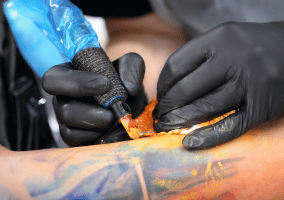Why Does How Long Does A Forearm Sleeve Tattoo Take Matter?
When it comes to getting a forearm sleeve tattoo, one of the most common questions that people have is how long the process will take. Understanding the time commitment involved in getting a tattoo is crucial for both tattoo artists and enthusiasts alike. Whether you’re a first-time tattoo recipient or a seasoned ink lover, knowing how long a forearm sleeve tattoo takes can help you plan your appointment, manage your expectations, and ensure the best possible outcome for your new body art.
Step-by-Step Explanation of How Long Does A Forearm Sleeve Tattoo Take
Getting a forearm sleeve tattoo is a multi-step process that typically involves several sessions with your tattoo artist. The length of time it takes to complete a forearm sleeve tattoo can vary depending on the size and complexity of the design, as well as your own pain tolerance and healing speed. Here’s a breakdown of the general timeline for getting a forearm sleeve tattoo:
- Consultation: Your first appointment with your tattoo artist will involve discussing your design ideas, placement, and overall vision for your forearm sleeve tattoo. This initial consultation is crucial for establishing a solid foundation for your tattoo.
- Design and Planning: Once you and your artist have finalized the design for your forearm sleeve tattoo, the next step is to prepare for the actual tattooing process. This may involve creating stencils, selecting colors, and making any necessary adjustments to the design.
- Tattoo Sessions: Depending on the size and complexity of your forearm sleeve tattoo, you may need to schedule multiple sessions with your artist to complete the design. These sessions can range from a few hours to several days, depending on the intricacy of the artwork.
- Healing and Aftercare: After each tattoo session, it’s essential to follow proper aftercare guidelines to ensure that your tattoo heals properly. This includes keeping the tattoo clean and moisturized, avoiding direct sunlight, and refraining from picking at scabs.
Practical Tips for Getting a Forearm Sleeve Tattoo
When it comes to getting a forearm sleeve tattoo, there are a few practical tips that can help make the process smoother and more enjoyable for both you and your tattoo artist. Here are some expert recommendations for getting a forearm sleeve tattoo:
- Choose a Reputable Tattoo Artist: Take the time to research and choose a skilled and experienced tattoo artist who specializes in forearm sleeve tattoos. Look at their portfolio, read reviews, and ask for recommendations from friends.
- Communicate Clearly: Make sure to clearly communicate your design ideas, expectations, and any concerns with your tattoo artist before starting the tattooing process. Good communication is key to ensuring a successful outcome.
- Follow Aftercare Instructions: Proper aftercare is essential for the healing process of your forearm sleeve tattoo. Listen to your artist’s recommendations and follow their aftercare instructions closely to avoid complications.
Conclusion
Understanding how long a forearm sleeve tattoo takes is crucial for anyone considering getting this type of body art. By following the steps outlined in this guide and implementing the practical tips provided, you can ensure a successful and enjoyable forearm sleeve tattoo experience. Remember to do your research, communicate clearly with your tattoo artist, and prioritize proper aftercare to achieve the best results for your new tattoo.
FAQs
How many sessions does it typically take to complete a forearm sleeve tattoo?
The number of sessions needed to complete a forearm sleeve tattoo can vary depending on the size and complexity of the design. On average, most forearm sleeve tattoos require multiple sessions spread out over several weeks or months.
Does getting a forearm sleeve tattoo hurt?
Tattoo pain is subjective and can vary from person to person. While some people may find getting a forearm sleeve tattoo uncomfortable, others may tolerate the pain well. It’s essential to communicate any discomfort with your tattoo artist during the process.











